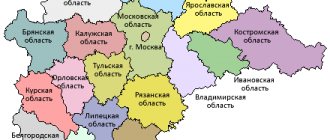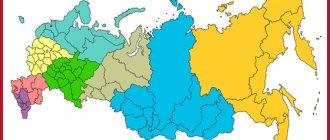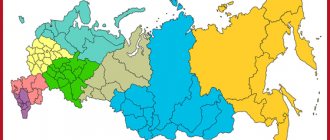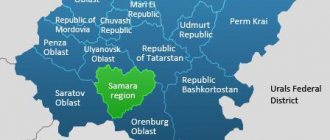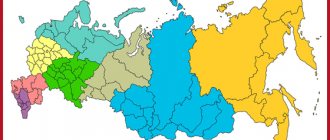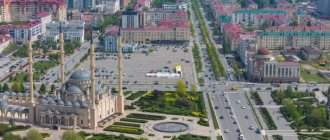The Yaroslavl region is one of the historical regions of our country. The Yaroslavl region has incredible natural beauty and a rich history. Vast spacious fields give way to centuries-old pine trees, oak and birch groves, large lakes and small rivers.
The area is very hospitable and is ready to welcome guests to any of the recreation centers. Every resident of our country should visit here sooner or later. It is in protected forests and historical cities that you can feel Russian history, identity, and learn the centuries-old secrets of the Russian land.
List of subjects of the Central Federal District:
| Subject | Center | Population million people | Area sq.km |
| Moscow | 12,3 | 2511 | |
| Ivanovo region | Ivanovo | 1,023 | 21437 |
| Lipetsk region | Lipetsk | 1,156 | 24047 |
| Oryol Region | Eagle | 0,755 | 24652 |
| Tula region | Tula | 1,49 | 25679 |
| Belgorod region | Belgorod | 1,55 | 27134 |
| Vladimir region | Vladimir | 1,39 | 29084 |
| Kaluga region | Kaluga | 1,016 | 29777 |
| Kursk region | Kursk | 1,123 | 29997 |
| Tambov Region | Tambov | 1,039 | 34462 |
| Bryansk region | Bryansk | 1,22 | 34857 |
| Yaroslavl region | Yaroslavl | 1,27 | 36177 |
| Ryazan Oblast | Ryazan | 1,12 | 39605 |
| Moscow region | Moscow | 7,43 | 44379 |
| Smolensk region | Smolensk | 0,95 | 49779 |
| Voronezh region | Voronezh | 2,3 | 52216 |
| Kostroma region | Kostroma | 0,65 | 60211 |
| Tver region | Tver | 1,3 | 84201 |
General characteristics of the Central Federal District
The Central Federal District has a population of 39 million 216 thousand people. This is almost 27% of the entire population of the Russian Federation. Density: 60.3 people per square kilometer. The urban population accounts for 82%, cities - 310. In general, the district consists of small areas, however, they are all densely populated.
It has no access to the sea or the world's oceans. The total area is 650,205 square kilometers. It is noteworthy that the Central Federal District consists entirely of regions (except for Moscow). The district has borders with two countries: Belarus in the west and Ukraine in the southwest.
Climate and geography of the Central Federal District
The Central Federal District is located on the East European Plain, there are a number of hills (Central Russian, Valdai), but in general the territory of the district can be considered flat, there are no high mountains here. The highest point is 347 meters. Natural zones: mixed forest and deciduous forest mainly in the north, steppe and forest-steppe mainly in the south.
The climate throughout the Central Federal District is temperate continental, the average temperature depends on the latitude, ranging from -7 to -14 in January and from +16 to +22 degrees Celsius in July.
The largest rivers of the Central Federal District: Western Dviga, Dnieper, Don, Volga. There are practically no large lakes, but there are many reservoirs, which are the most significant water bodies (Rybinskoye, Kostroma, etc.).
A little history
Yaroslavl is one of the oldest cities in Russia. There are several hypotheses for its foundation. Many of them proceed from the assumption that Yaroslavl was founded in 1010 by the Kyiv prince Yaroslav the Wise as a fortress located on the right bank of the Volga. Previously, there was an ancient Russian settlement in that place called “Bear Corner”. According to legend, Yaroslav surprised local residents by killing a bear, which they considered a sacred beast. The legend of this fight was subsequently reflected in the city’s coat of arms.
Economy and resources of the Central Federal District
The Central Federal District has a developed network of roads and railways. Thus, highways account for 117 thousand kilometers or 22% of their total Russian length. Railways - 17.2 thousand kilometers (20% of the all-Russian figure). The number of industrial enterprises is huge; even listing the most significant ones would require a separate article.
There are also mineral deposits, including very significant ones, such as the Kursk Magnetic Anomaly. On the territory of the Central Federal District there are deposits of ora, peat, granite, coal, phosphorites and bauxites, as well as a number of other minerals, are mined.
Tourism in the Central Federal District
You can read more about tourism and the attractions of the Central Federal District in the descriptions of the regions. The district is very attractive for tourists; there are both natural and architectural attractions. Moscow alone attracts millions of tourists every year, but there is also the Golden Ring of Russia and hundreds of other interesting places.
From a tourism point of view, the Central Federal District stands out from almost all other districts due to its developed transport infrastructure. Almost any part of the district can be reached without problems, and there is no need to talk about popular and famous places.
YAROSLAVL IS ONE OF THE CULTURAL CENTERS OF RUSSIA
Art critics call Yaroslavl “the Florence of the Russian North” for its vibrant mixture of architectural styles and trends. Tourists from all over the world come here to admire the numerous temples and monasteries - masterpieces of architecture of the 17th century - the “golden age” of Yaroslavl. The churches of Elijah the Prophet and John the Baptist and the Volzhskaya embankment with its magnificent gazebos are considered unique in beauty. The Yaroslavl school of icon painting, monumental painting and tile-making received wide fame and world recognition.
In 2005, the historical center of Yaroslavl was included in the UNESCO World Heritage List. More than a million tourists visit the region every year.
In 2010, Yaroslavl celebrated its 1000th anniversary.
Brief description of the subjects of the Central Federal District
Below is a brief description for tourists of all subjects of the Central Federal District. The information is given briefly so that you can briefly learn about each area and choose the most interesting direction for yourself. By following the links in the article, you can get acquainted in detail with the description of each subject of the Central Federal District, as well as find out other useful information.
Belgorod region
Formed on January 6, 1954. The Belgorod region has a large number of natural, cultural and historical attractions. The transport and tourism infrastructure is quite well developed.
The Belgorod region is low-water, there is not only a small amount of precipitation, but also a very small number of reservoirs. Swamps, lakes and rivers occupy no more than 1% of the region's territory.
Bryansk region
Bryansk region was formed on July 5, 1944. On its territory there are more than four thousand historical monuments, more than 10 sanatoriums, four dozen hotels, and there are also recreation centers. In the Central Federal District, the Bryansk region occupies a worthy place in terms of the number of tourists, which is also facilitated by the fact that it borders Ukraine and Belarus.
The main directions of tourism: active tourism, cultural and educational tourism, ecotourism, as well as various festivals.
Vladimir region
It was formed on August 14, 1944. The Vladimir region is included in the “Golden Ring of Russia” route, so many tourists visit it. It should be noted that about 70% of tourists come to the region for cultural and educational purposes.
There are 26 museums in the Vladimir region, and there are eight UNESCO World Heritage Sites. Active measures are being taken in the region to develop tourism, a separate website operates, and there are tourist centers.
Voronezh region
The Voronezh region was formed on June 13, 1934. It is the southernmost region of the Central Federal District of Russia. The region has seven historical cities, more than 2,600 historical monuments, three nature reserves, and 20 museums. The tourism infrastructure is developed quite well, but the region plans to further develop this area.
Moscow
In Moscow, tourism is a very important part of the city's economy. More than 13 million people visit Moscow every year. The tourism infrastructure is very well developed. Actually, it is impossible to write about Moscow in one paragraph.
Ivanovo region
The Ivanovo region is part of the “Golden Ring of Russia”. Tourism is a fairly important part of the region’s economy; there are many objects in the Ivanovo region that will be of interest to tourists. Recently, auto tourism has been actively developing - people come here for several days from Moscow and neighboring regions.
It is worth noting the climatic resort and museum town of Plyos, which is visited annually by up to half a million people (there is a ski resort nearby), cruise tourism is developing (on the Volga), festivals and other events are held. Many people come on shopping tours to buy textiles in Ivanovo.
Kaluga region
Tourism in the Kaluga region develops annually, more than 1.4 million people visit it and this number is growing. A characteristic feature of the Kaluga region is that there are quite a few types of tourism here: ecotourism, ethnotourism, agrotourism, cultural and educational, event.
It is the leader of the Central Federal District in rural tourism; such sites as Devil's Settlement, Kaluga Zaseki, and Ugra National Park are popular. There are 1,800 archaeological, architectural and historical monuments in the Kaluga region. Pilgrimage tourism is very developed: there are monasteries known throughout the country (Optina Pustyn, etc.).
Festivals and other interesting and thematic events are held annually. The tourism infrastructure in the Kaluga region is quite well developed.
Kostroma region
In terms of attractiveness for tourists, the Kostroma Region occupies a worthy place among all the constituent entities of the Central Federal District. Its administrative center, Kostroma, is part of the “Golden Ring of Russia”; in addition, cruise, ethnographic, recreational and other types of tourism are developed.
In the Kostroma region there are 32 museums, 18 natural attractions, about 2.5 thousand historical, architectural and archeological monuments. The Kostroma region is also notable for the presence of 79 protected natural areas that attract ecotourism enthusiasts.
Kursk region
The Kursk region is rich in water resources, especially when compared with a number of other regions of the Central Federal District. That is why it is popular among lovers of fishing, hunting, and eco-tourism.
The Kursk region has many cultural attractions, significant architectural monuments and interesting museums.
Lipetsk region
The Lipetsk region is popular among fishermen, hunters and ecotourists. The region has more than 840 historical and architectural monuments, and there are opportunities for active winter and summer recreation.
Moscow region
The Moscow region is the leader of the Central Federal District and one of the leaders in the Russian Federation in terms of the number of cultural heritage sites: there are about 6,500 of them. The region has conditions for all types of tourism, the tourism infrastructure is very well developed.
Oryol Region
Cultural, educational and ecological tourism predominates in the region. There are a large number of museums, including the Turgenev estate; it is also worth noting the Oryol Polesie National Park, which is visited annually by thousands of nature lovers. A special feature of the Oryol region is literary tourism; there are a lot of museums of famous Russian writers in the region.
Ryazan Oblast
The Ryazan region boasts a developed tourism industry; there are nature reserves, museums, monasteries, beautiful natural landscapes and a rich historical and cultural heritage. All this attracts lovers of all types of tourism. The most popular are ecotourism (outdoor recreation), as well as spa treatment and cultural tourism.
Smolensk region
In the Smolensk region there are more than 30 museums, 20 sanatoriums and resorts, there are interesting museums and natural areas. However, the region is not among the leaders in the Central Federal District in terms of the number of tourists. Nevertheless, this region is worth considering as interesting enough to visit.
Tambov Region
The region has 1,340 objects of historical and cultural heritage, 66 museums and a very large number of natural attractions, of which it is worth mentioning Barskaya Gora, the Voroninsky Nature Reserve, and the Catherine Dendrological Park.
A large number of recreation centers attract lovers of fishing and hunting; there are conditions for active summer and winter recreation. There are also facilities for agritourism. The region's tourism infrastructure is actively developing.
Tver region
The region is one of the leaders in the Central Federal District in terms of the number of tourists. It is curious that in the 80s of the last century the region ranked second in the RSFSR in terms of the number of tourists visiting it.
In the Tver region they pay very close attention to the tourism industry, 8 clusters have been created, of which we will separately mention Seliger, Russian Venice, and the String of Pearls. Almost all areas of tourism are developed, large and famous festivals are held (Invasion, Chanson Festival and others).
Tula region
The Tula region is especially popular among hunting and fishing enthusiasts: among all the constituent entities of the Central Federal District, it can be considered one of the leaders in this area. Wellness holidays are popular, there are natural attractions, as well as more than a thousand monuments of historical and cultural heritage.
Yaroslavl region
Three cities in the region are included in the “Golden Ring of Russia” (Rostov the Great, Pereslavl-Zalessky and Yaroslavl). There are 250 museums in the Yaroslavl region, a huge number of monuments of historical and cultural heritage. There are conditions for all types of tourism: recreational, health, cultural, educational, environmental, event and other types. According to estimates, the region is among the top 20 in Russia in terms of tourism potential.
The Central Federal District can be considered the leader of Russia in many indicators, primarily economic, due to which almost all subjects of the district are characterized by high population density.
How to get to Yaroslavl
The best way to get from the Russian capital to Yaroslavl is by train from the Yaroslavsky railway station. More than two hundred trains run through Yaroslavl, almost three dozen of them are branded. You will have to spend about four hours on the road.
You can get to Yaroslavl from Moscow by train. They also run from Yaroslavsky railway station. So, first you should get to Aleksandrov, then transfer to another train to Yaroslavl.
You can go by bus. In this case, the travel duration will be about six hours. Buses to Yaroslavl run from the Shchelkovskaya metro station, from the Central and Yaroslavl stations of the capital.
You can get from Moscow to Yaroslavl by car. From the capital there is the federal highway M-8 “Kholmogory”, along which you can get to your destination in four hours if there are no traffic jams leaving Moscow.
Planes fly from the capital to Yaroslavl. Travel time will be only one hour. Flights are operated by Sheremetyevo, Domodedovo and Vnukovo airports.
At least 10 trains run daily from St. Petersburg to Yaroslavl from Moskovsky Station. The duration of the trip will be more than 12 hours. There is a direct train from Ladozhsky Station once a day. Travel time will be almost 18 hours. You can also fly from the city on the Neva to Yaroslavl from Pulkovo by plane in a couple of hours. You can also go by car, but in this case you will have to spend at least 12-13 hours on the trip.


